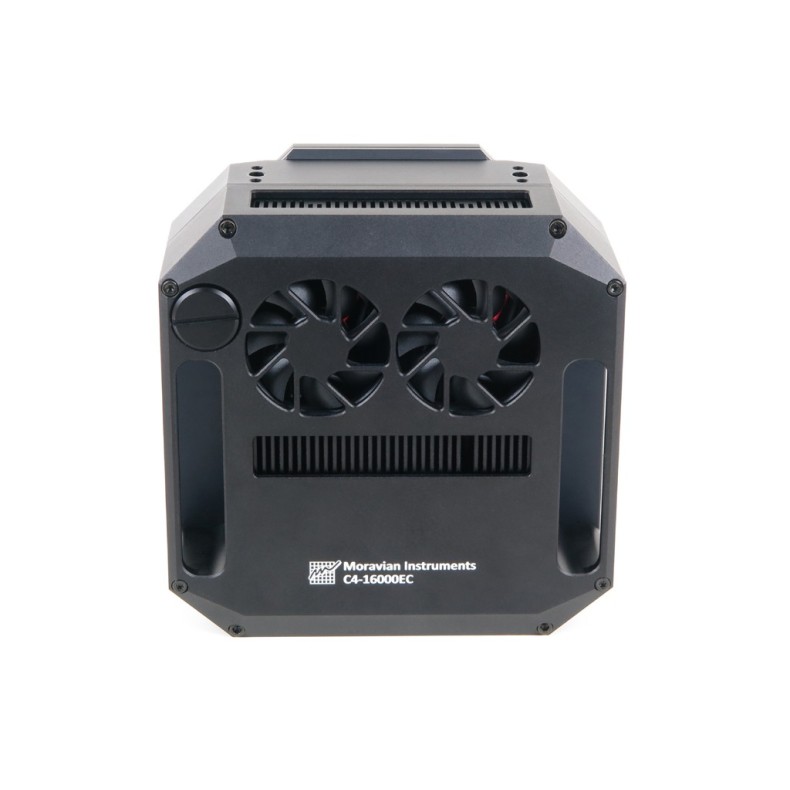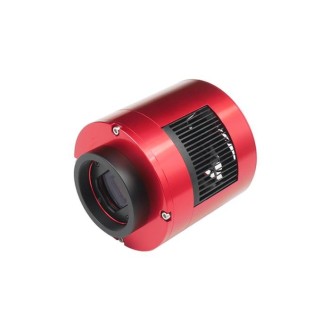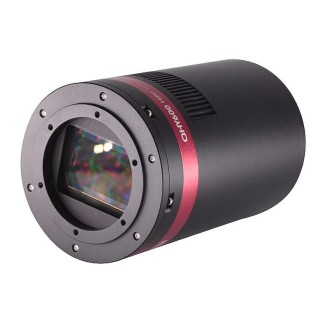
MORAVIAN C4-16000 camera with enhanced cooling
The sensors of the C4-16000 cooled scientific CMOS cameras offer the same geometry as the CCDs of the famous G4-16000 cameras: sensor size 37 × 37 mm, 9 μm pixels and 16 MPx (4k × 4k) resolution.
| Carrier | Description | Estimated Delivery | ||
|---|---|---|---|---|
 |
Home delivery - International | Home delivery - International |
Friday, 16 January - Friday, 23 January |
|

Home delivery - International
Home delivery - International
Estimated delivery:
Friday, 16 January - Friday, 23 January
MORAVIAN C4-16000 camera with enhanced cooling
The sensors of the C4-16000 cooled scientific CMOS cameras offer the same geometry as the CCDs of the popular G4-16000 cameras: 37 × 37 mm sensor size, 9 μm pixels and 16 MPx (4k × 4k) resolution. Also, the mechanical design of the C4 cameras inherits that of the G4 Mark II cameras, making the C4 camera line fully compatible with a wide range of telescope adapters, off-axis rail adapters, filter wheels, Ethernet adapters for cameras, guiding cameras, etc.
The mechanical design of the C4 series of astronomical CMOS cameras inherits from the earlier CCD-based G4 Mark II cameras, making the C4 camera line fully compatible with a wide range of telescope adapters, off-axis rail adapters, filter wheels, camera Ethernet adapters, guiding cameras, etc.
Extensive software and driver support allows the C4 camera to be used without the need to invest in any third-party software packages thanks to the included free SIPS software package. However, the ASCOM (for Windows) and INDI (for Linux) drivers and Linux driver libraries supplied with the camera provide a way to integrate the C4 camera with a wide variety of camera control programs.
C4 cameras are designed to work in cooperation with a personal computer (PC). Unlike digital still cameras, which are operated independently on the PC, scientific cooled cameras usually require a PC for operation control, downloading, image processing and storage, etc. To operate the camera, a computer is required that
Be compatible with a standard PC and run a modern 32-bit or 64-bit Windows operating system.
Be it an x86 or ARM-based computer running the 32-bit or 64-bit Linux operating system.
The C4 cameras are designed to be connected to the host PC via a very fast USB 3.0 port. Although the C4 cameras are still compatible with the older (and slower) USB 2.0 interface, the image download time is significantly longer.
Alternatively, it is possible to use the Moravian Camera Ethernet Adapter. This device can connect up to four Cx (and CCD-based Gx) cameras of any type (not only C4, but also C1, C2 and C3) and offers a 1 Gbps and 10/100 Mbps Ethernet interface for direct connection to the host PC. As the PC then uses the TCP/IP protocol to communicate with the cameras, it is possible to insert a WiFi adapter or other network device into the communication path.
The download speed is naturally much slower when the camera is connected via an Ethernet adapter, especially when compared to the direct USB 3 connection.
C4 cameras require an external power supply to operate. It is not possible to run the camera from the power lines provided by the USB cable, which is common for simple cameras. C4 cameras integrate CMOS sensor cooling, shutter and possibly the high efficiency filter wheel, so their power requirements significantly exceed the USB line power capabilities. On the other hand, the separate power supply eliminates the problems of voltage drop on long USB cables or removal of laptop batteries, etc.
Also note that the camera must be connected to some optical system (e.g. telescope) to capture images. The camera is designed for long exposures, necessary to acquire light from faint objects. If you plan to use the camera with the telescope, make sure that the entire telescope/mount configuration is capable of tracking the target object smoothly during long exposures.
C4 camera overview
The C4 camera head is designed to be easily used with an array of accessories to meet various observation needs.
Unlike the smaller C2 and C3 camera models, which offer the option of integrating the filter wheel into the camera housing, the large sensors of the C4 cameras require 50×50 mm square filters, which are too large to fit on the internal filter wheel. Therefore, using the external filter wheel is the only option for C4 cameras.
Two sizes of external filter wheels are available:
Medium wheel "M" for 5 square filters 50 × 50 mm unmounted.
Large "L" wheel for 7 unmounted 50 × 50 mm square filters.
CMOS sensor and camera electronics
The C4 cameras are equipped with Gpixel GSENSE4040 CMOS detectors with a resolution of 4096 × 4096 pixels. The pixel size is 9 × 9 μm, which is a light-sensitive area of almost 37 × 37 mm.
The GSENSE4040 sensor is equipped with 12-bit ADCs (analog-to-digital converters) only. However, there are two sets of ADCs inside the sensor, each capable of digitizing the image with different gain - one set of ADCs uses the low gain channel, while the second set uses the high gain channel. The two 12-bit outputs from each set of ADCs can be combined to produce a single image with a true 16-bit dynamic range (this combined image is often referred to as 16-bit HDR for High Dynamic Range).
Camera electronics
The main function of the CMOS camera electronics, besides sensor initialization and some auxiliary functions, is to transfer the data from the CMOS detector to the host PC for storage and processing. Therefore, unlike CCD cameras, the design of CMOS cameras cannot influence some important camera characteristics, such as dynamic range (bit depth of digitized pixels).
Sensor linearity
The sensors used in the C4 cameras show very good linearity in response to light. This means that the camera can be used for advanced research projects, such as photometry of variable stars and transiting exoplanets, etc.
Download speed
The C4 camera is equipped with an integrated RAM memory, capable of holding several frames at full resolution. Therefore, downloading the image to the host computer does not influence the image digitization process, as the download only transfers the already digitized images from the camera's memory.
The time required to download a single frame depends on the reading mode and also on whether the fast USB3 or the slower USB2 is used:
Conversion factors and read noise
The C4 cameras do not offer users the possibility to adjust the gain, apart from the two fixed channels of low and high gain. The 16-bit HDR image covers the full dynamic range of the sensor and manipulation with gain would not provide additional benefits.
Exposure control
C4 cameras are capable of very short exposures, the shortest exposure time is approximately 21 μs. However, the sensor employs the so-called "rolling shutter". This means that the exposure does not start on the entire sensor at once, but the exposure of the following lines starts with 21 μs delay and the entire sensor is illuminated 8.6 ms after the exposure starts. Similarly, the end of the exposure and the digitizing of the pixels is done line by line with the same delay between lines.
There is no practical limit to the maximum exposure duration, but in reality, longer exposures are limited by sensor saturation, either by incoming light or dark current (see next chapter on sensor cooling).
Hardware Binning
The GSENSE4040 sensor used implements the 2 × 2 binning mode in hardware, in addition to the normal 1 × 1 binning.
However, the backside illuminated version of this GSENSE4040BSI sensor does not implement any binning modes in hardware. In addition, the camera driver and user applications offer a much wider variety of binning modes up to 3 × 3 and 4 × 4 pixels, as well as all combinations of 1 × 2, 1 × 3, 2 × 4, etc. asymmetric binning modes. Thus, the camera driver performs all binning combinations by software and does not depend on the limited binning capabilities of the sensor hardware.
The downside of software binning is the same download time as full resolution 1 × 1 binned images. For typical astronomy use, the small fraction of a second download time is irrelevant, but for very download time sensitive applications, the driver offers the use of 2 × 2 hardware binning. This mode can be turned on and off via the configuration file parameter 'cXusb.ini', located in the same directory as the driver DLL file 'cXusb.dll' itself.
Mechanical specifications
The compact and robust camera head measures only 154 × 154 × 65 mm (approx. 6 × 6 × 2.6 in.) for the model with standard cooling. The improved cooling increases the chamber depth by 11 mm.
The head is CNC machined from high quality aluminum and anodized black. The head itself contains a USB-B (device) connector and a 12 V DC power plug; no other parts (CPU box, USB interface, etc.) are needed, except for a power "brick". Another connector allows control of the optional external filter wheel. The integrated mechanical shutter enables streak-free image readout as well as automatic dark frame exposures, which are necessary for unattended robotic setups.
- Internal mechanical shutter Yes, lamellar shutter
- Shortest exposure time 21 μs (electronic shutter)
- Longer exposure time Limited only by chip saturation
- Head dimensions 154 mm × 154 mm × 65 mm (standard cooling)
- 154 mm × 154 mm × 76 mm (improved cooling)
- Rear focal length 33.5 mm (adjustable adapter base)
- Weight of head with standard cooling 1.6 kg (without filter wheel)
- 2.5 kg (with external filter wheel "M")
- 2.8 kg (with external filter wheel "L")
- Weight of the improved cooling head 1.8 kg (without filter wheel)
Mechanical shutter
The C4 cameras are equipped with a mechanical shutter, which is a very important feature that allows unattended observations (fully robotized or only with remote settings). Without the mechanical shutter, it is not possible to automatically acquire the dark frames, necessary for correct image calibration, etc.
The mechanical shutter of the C4 cameras is designed to be as reliable as possible, the number of opening/closing cycles is virtually unlimited, because there are no surfaces rubbing against each other. The price of high reliability is slow shutter movement. Fortunately, the mechanical shutter is not needed for exposure control, only for taking dark frames and possibly bias frames - all CMOS sensors used are equipped with electronic shutter.
The camera firmware optimizes the shutter operation to avoid unnecessary movements. If a series of light images is taken immediately one after the other, the shutter remains open so as not to introduce a rather significant delay of the close/open cycle between each subsequent pair of light images. In case the next image has to be dark or bias, the shutter closes before the exposure of the dark frame and vice versa - the shutter remains closed if a series of dark frames is acquired and opens only before the next light frame. If no exposure is made for approximately 1 second while the shutter is open (i.e. after a light image exposure), the camera firmware closes the shutter to cover the sensor from incoming light.
Technical Specifications:
CMOS sensor: Gsense 4040 CMT
Sensor dimensions: 37x37mm
Pixel size: 9 μm
Resolution: 4160 x 4196 pixels (16MP)
Interface: USB 3.0
MORAVIAN C4-16000 camera with enhanced cooling
















